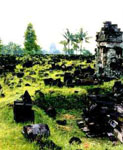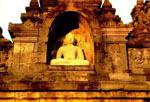|
Selasa, 16 September 2008 |
| Majapahit Kingdom
|
 The kingdom of Majapahit, with its capital in East Java, flourished at the end of what is known as Indonesia's 'classical age'. This was a period in which the religions of Hinduism and Buddhism were predominant cultural influences. Beginning with the first appearance of Hinduized kingdoms in the archipelago in the 5th century A.D., this classical age was to last for more than a millennium, until the final collapse of Majapahit in the early 16th century and the establishing of Java's first Islamic sultanate at Demak. The kingdom of Majapahit, with its capital in East Java, flourished at the end of what is known as Indonesia's 'classical age'. This was a period in which the religions of Hinduism and Buddhism were predominant cultural influences. Beginning with the first appearance of Hinduized kingdoms in the archipelago in the 5th century A.D., this classical age was to last for more than a millennium, until the final collapse of Majapahit in the early 16th century and the establishing of Java's first Islamic sultanate at Demak.
Legend has it that Hindu civilization and culture were introduced to Java in A.D. 78 by the sage Aji Saka. This figure is often associated with Agastya, the patron saint of southern India, whose image is a common sight on the southern walls of Central Javanese Hindu temples. Not unlike the god Neptune in appearance, Agastya is also recognized as Shiwa in his form of divine teacher. When he first brought the message of Hinduism to southern India, it is said that he stood in the north and faced south.
 The way in which Hindu/Buddhist culture was transmitted to Indonesia is still not yet fully understood. Older theories suggesting immigration and colonization by Indian merchants and settlers have tended to lose favour in the light of recent advances made in the fields of history and archaeology. The case seems rather to have been one in which the native Indonesians themselves played an active role in the selection and adaptation of foreign cultural forms, through which they were inspired. The way in which Hindu/Buddhist culture was transmitted to Indonesia is still not yet fully understood. Older theories suggesting immigration and colonization by Indian merchants and settlers have tended to lose favour in the light of recent advances made in the fields of history and archaeology. The case seems rather to have been one in which the native Indonesians themselves played an active role in the selection and adaptation of foreign cultural forms, through which they were inspired.
The great flowering of Hindu-Javanese civilization which sprang up in Central Java during the 8th and 9th centuries may be seen as the product of a dialogue between, on the one hand, the established forms of classical Hinduism and Buddhism, and on the other, the innovative qualities of a society whose traditional beliefs and customs were already firmly entrenched.
The oldest datable evidence of a Hindu civilization in Indonesia comes from Kutei in eastern Kalimantan (Borneo). Stone inscriptions, written in sanskrit and dating from around A.D. 400, record the reign of a King Mulawarman. At about the same time, in West Java, there existed a kingdom named Tarumanagara, yet more than this little is known, on account of the scarcity of archaeological remains.
It is not until the 7th and 8th centuries that the picture clearer.This period, which saw the rise of the maritime empire of Sriwijaya in south eastern Sumatra, as well as the emergence of the Central Javanese kingdom of Mataram, marked the beginning of a golden age in Indonesian history. the rise of the maritime empire of Sriwijaya in south eastern Sumatra, as well as the emergence of the Central Javanese kingdom of Mataram, marked the beginning of a golden age in Indonesian history.
In the whole course of my life I have never met with such stupendous and finished specimens of human labour, and of the science and taste of ages long since forgot, crowded together in so small a compass as in this little spot'
Thus exclaimed Captain George Baker when first confronted by the ruins of Candi Sewu, or the 'Temple of a Thousand Buddhas', at Prambanan, near Yogyakarta, early in the 19th century. Baker, who had been given the task of surveying the antiquities of Java by Thomas Stamford Raffles, then governor of the island, was no stranger to India, nor to other parts of south east Asia.
Yet, the extensive ruins to be found in the mountains and on the plains of Central Java were beyond anything which he had yet seen. The remains of Borobudur, Prambanan, Sewu, the temple sites of Dieng and Gedong Songo, are just a few of the archaeological treasures which to this day continue to arouse similar expressions of wonder and astonishment.
Through the study of temple remains and the deciphering of ancient inscriptions on stone and metal, historians have been able to establish a quite coherent chronology for the period. Tracing an outline, the ruling power in 8th and 9th century Central Java appears to have been shared by two dynasties, whose exact relationship is not fully clear. According to the earliest known inscription, dating from A.D.732, there was a Hindu king named Sanjaya, who united the kingdom of Java and whose descendants are recorded in inscriptions for the following two centuries.
Not long after the appearance of Sanjaya, a dynasty bearing the title Sailendra emerged as the supreme authority on the southern plains. The Sailendra were adherents of Mahayana Buddhism, the religion which inspired them to embark on one of the most ambitious building programmes known to history. In the space of just one century they commissioned the construction of a vast number of religious monuments, some very large, built from hand cut blocks of volcanic stone. The remains of many of these buildings are still visible, some of the,more well known including the temples of Kalasan, Sari, Sewu, Sojiwan, Mendut, Ngawen, Pawon, as well as the massive 'temple mountain' of Borobudur, one of the architectural wonders of the world.
Sometime during the early to mid 9th century, a marriage alliance between a Sailendra princess and a king from the dynasty of Sanjaya seems to have resulted in the end of Sailendra rule in Java. At about the same time, the great Shiwa temple at Prambanan was constructed, perhaps as a monument to the return to power of the Sanjaya dynasty.
Yet, the Prambanan temple complex was barely completed when, for reasons which are still not fully comprehended, Central Java all but vanished from the records of history for about five centuries. One reason for this sudden silence, which began after the palace was moved to East Java by Mpu Sindok in A.D. 929, may well have been a violent eruption of Mt Merapi, which overlooks the plains of both Borobudur and Prambanan. In recent years, more and more archaeological sites have been discovered buried under metres of lava and volcanic dust, indicating the occurrence of a serious calamity which could well have taken place about a thousand years ago. |
|
| 0 Comments: |
|
| |
 |
| |
|
|
|
|





